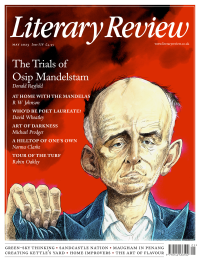Barnaby Crowcroft
On the Polo Fields of Egypt
A Cultural History of the British Empire
By John M MacKenzie
Yale University Press 418pp £25
One April morning in 1908, in the Sudanese desert south of Khartoum, a young British colonialist, Colin Scott-Moncrieff, was practising polo on his horse when reports came in that a new Mahdi had declared himself in a nearby village. Scott-Moncrieff’s more experienced Egyptian deputy urged caution – to which Scott-Moncrieff responded, ‘Are you a woman, or an officer?’ Scott-Moncrieff mounted his camel and rode off to question the suspected Islamic millenarian. A few minutes after arriving at the village, he was set upon and stabbed to death by the would-be Mahdi’s followers. He was twenty-four years old.
A mere political history of this episode – setting out, for example, what on earth the British were doing ruling over early 20th-century Sudan – seems in many ways inadequate to explain what today makes it so extraordinary. What we really want to know is what culture can possibly have produced such a specimen of British imperial youth – brazenly sexist, preternaturally brave and courageous, and, perhaps most remarkable for today’s work-from-home generation, the kind of young man who would habitually practise polo before breakfast?
More than anyone, it is John MacKenzie, professor at the University of Lancaster and founding editor of Manchester University Press’s Studies in Imperialism series, who can help us to answer such questions. A Cultural History of the British Empire is both a summation of all that has been done in this burgeoning field and an agenda for future research. At its best, it resembles a readable encyclopedia, packed with stories of the men and women, the technologies and recreational pastimes that underpinned Britain’s empire. Individual chapters on things like imperial ceremony, equestrian and field sports, photography, statuary, the press, theatre, film and radio offer entrées into major fields of study. Coupled with this is a bibliophile’s dream (or perhaps nightmare) showcasing the hundreds of scholarly and popular publications, exhibition catalogues, coffee-table volumes, depositories and even online archives that exist on specific topics, such as colonial photography. It is difficult to imagine even a casual reader putting down MacKenzie’s book and not wanting to know more about one or two of its many characters, such as (to name just the photographers) Lala Deen Dayal (1844–1905), favoured photographer of the Prince of Wales, the Nizam of Hyderabad and Lord Curzon when he was viceroy of India, or Soloman Osagie Alonge (1911–94), court photographer to the Nigerian kings of Benin, or the ‘photographer-prince’ Maharaja Sawai Ram Singh II (1833–80), who combined his hobby with ruling the state of Jaipur.
Perhaps the most magnificent chapter of the book – one that would merit reprinting as an illustrated coffee-table book on its own – is on the curiously neglected history of the art of the British Empire. MacKenzie traces the origins of imperial art to the three voyages of Captain Cook

Sign Up to our newsletter
Receive free articles, highlights from the archive, news, details of prizes, and much more.@Lit_Review
Follow Literary Review on Twitter
Twitter Feed
'A charming and amusing personal history'
Don't miss this brilliant @Lit_Review review of #WorldCupFever 👇
@KuperSimon's must-read footballing journey in nine tournaments is out now ⚽️🏆
Michael Taylor - The Beautiful Game
Michael Taylor: The Beautiful Game - World Cup Fever: A Footballing Journey in Nine Tournaments by Simon Kuper; Th...
literaryreview.co.uk
In the summer of 1918, the Caspian port of Baku played host to a remarkable group of Allied soldiers, sent to defend oil wells against the Ottomans.
Anna Reid recounts their escapades.
Anna Reid - Mission Impossible
Anna Reid: Mission Impossible - Mavericks: Empire, Oil, Revolution and the Forgotten Battle of World War One by Nick Higham
literaryreview.co.uk
Alfred, Lord Tennyson is practically a byword for old-fashioned Victorian grandeur, rarely pictured without a cravat and a serious beard.
Seamus Perry tries to picture him as a younger man.
Seamus Perry - Before the Beard
Seamus Perry: Before the Beard - The Boundless Deep: Young Tennyson, Science, and the Crisis of Belief by Richard Holmes
literaryreview.co.uk